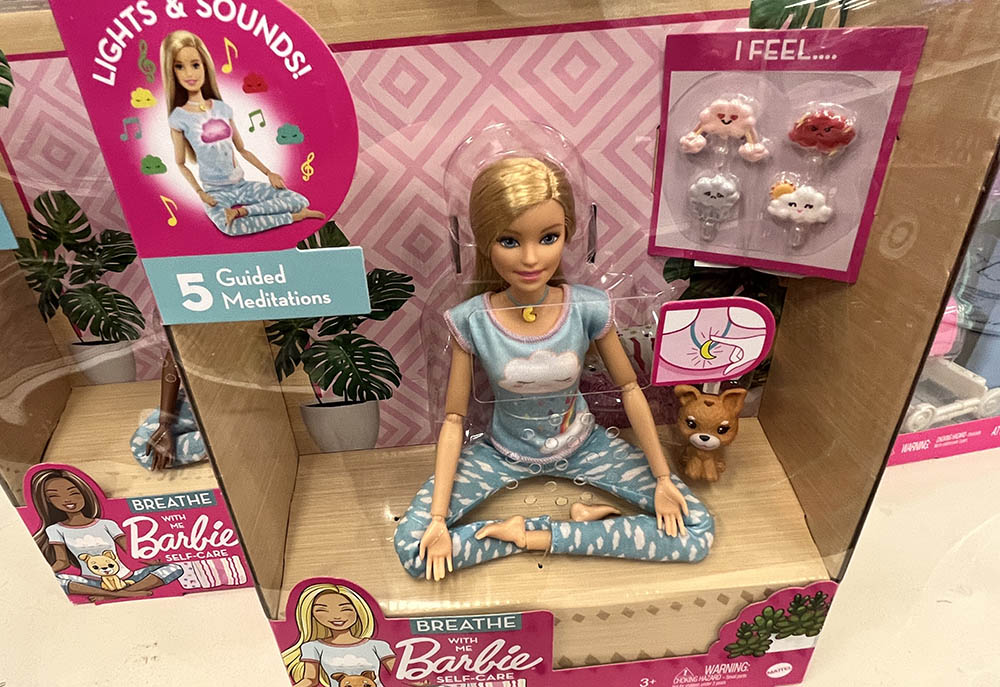
"Breathe With Me Barbie" dolls are seen for sale on a store shelf. (NCR photo/Teresa Malcolm)
Catholics, we need to talk about yoga Barbie.
The Breathe With Me Barbie meditation doll hit the shelves of major retail stores with five guided mindfulness meditations shortly before the COVID-19 pandemic. This "yoga Barbie" offers breathing exercises, known in yogic philosophy as pranayama, accompanied by her 15 "joints" so that she can also practice yoga asana, the postures of yoga. Both asana and pranayama are a part of the eight-limbed yoga system of Patanjali.
This isn't the only example of Mattel's attempt at entering the health and wellness industry. Mattel's Wellness Barbie collection also included Barbie Made to Move, whose cover shots show Barbie in yoga poses and Barbie Fitness Doll, which includes a miniature yoga mat as an accessory.
But Mattel is not the only business that capitalizes on consumer-based yoga practices. Each year, the yoga industry brings in billions of dollars from classes, retreats and even spandex yoga pants. Since the establishment of International Yoga Day in 2014, brands or businesses explicitly or adjacently related to yoga will use the day as a time to offer sales and maybe even a free yoga class.
The United Nations went as far as instituting International Yoga Day to be celebrated every year on June 21. The date was said to be chosen to symbolically mark the summer solstice, or the longest day in the year, but only in the Northern Hemisphere. Therefore, the date caters to popular American and European renditions of yoga as essentially part of the health and wellness industry.
The term "yoga" relates both to an ancient philosophy and a modern fitness regimen. Elizabeth de Michelis refers to the fitness practices in yoga studios today as "modern postural yoga," though still yoga nonetheless. Modern postural yoga's current position as an industry certainly has evolved from origins in South Asian traditions, however loosely called yoga it may seem now.
The modern yoga movement — if you pardon the pun — and its historical development present a unique opportunity for Americans to break the mold of white heteronormative narratives and overgeneralized assumptions. Luckily for Catholics, Barbie is here to help.
Advertisement
The first Indian Barbie was released in 1982, only one year after Mattel released "Oriental Barbie," as a part of the Barbie Dolls of the World collection. Mattel followed suit by releasing another Barbie Dolls of the World India Barbie in 1996, the Princess of India Barbie in 2000, and the Festivals of the World collection Diwali Barbie in 2006. We may pride Barbie for including Indian representation here, but this narrow characterization of women leaves out a fluidity of belonging. As it so happens, the first-ever Desi (South Asian American) Barbie was not released until March 2022.
While Mattel does sell the "yoga Barbie" in two skin tones, the white, thin, able-bodied, female yoga Barbie personifies the rampant heteronormative problems today. But as we know, society, the yoga industry and even the Catholic Church are more than one cookie-cutter image.
Like yoga, the Catholic Church has survived many generations — though the earliest written examples of yogic philosophy predate the birth of Christ. The teachings of the Catholic Church and yoga through these thousands of years constantly changed due to communicative technology, societal influence and, let's face it, colonialism. Yet both remained planted somewhat in their respective origins. This evolution encourages us to hold multiple truths. What was, can still be — even if it looks different.
Within two days of the release of the yoga Barbie, I received several text messages and Facebook comments about the controversy. A Christian singer and speaker published a Facebook post explaining the ulterior motives of the Breathe With Me Barbie as demonic. The post's author was born in India, the homeland of the yoga tradition.
What shocked me the most was not the author's position on yoga but rather the blonde-hair, blue-eyed Barbie sitting in sukasana, or easy seat, with tightly fitted cloud pajamas. How did we get here?
We are not only target-marketing kids to convince their parents to buy this doll, but we are also teaching children that they are required to pay to take care of themselves. In the process, we are reducing the practice of a cultural tradition to a white-washed and superficial consumer-based product.
Sure, breathing techniques are great. They have been used across cultures and religions, even within the Christian practice of reciting the Jesus prayer. But we don't need to buy a Barbie to teach our children how to breathe and take care of themselves holistically.
I am not by any means advocating for everyone to have a right to free yoga. Please pay your yoga teachers, who have spent hours learning and training to offer these services. I would even implore you to find South Asian yoga teachers because they have consistently been excluded from their own tradition.
But if Catholics are to enact the golden rule of loving your neighbor as yourself, we must learn to accept the diversities of faith and flesh.








